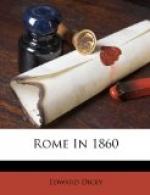By the time I reached Subiaco, the first day of the fair was at its height. The topography of the place is of the simplest description,—a narrow street running up a steep hill, with a small market-place; on the summit stands a church; half a dozen cul-de-sac alleys on the right, terminated by the wall that hems in the river at their feet; a long series of broken steps on the left, leading to a dilapidated castle, where the Legate ought to reside, but does not; such are the main features of the town. In fact, if you fancy Snow Hill, Holborn, shrunk to about a quarter of its width, all its houses reduced to much such a condition as that gaunt corner-building which for years past has excited my ungratified curiosity; Newgate gaol replaced by the facade of a dingy Italian church; the dimensions of the locale considerably diminished; and a small section of the dark alleys between the prison and Farringdon Street, bounded by the Fleet-ditch uncovered; you will have a very fair impression of the town of Subiaco.
The fair, such as it was, was confined to this High Street and to the little square at its head. The street was filled with people, chiefly men, bartering at the doors of the un-windowed shops. A very small crowd would fill so small a place, but I think there could hardly have been less than a thousand persons. Cutlery and hosiery of the rudest kind seemed to be the great articles of commerce. There were, of course, an office of the Pontifical Lottery, which was always crammed, an itinerant vendor of quack medicines and a few scattered stalls (not a single booth by the way), where shoes and caps and pots and pans and the “wonderful adventures of St Balaam” were sold by hucksters of Jewish physiognomy. Lean, black-bristled pigs ran at every step between your legs, and young kids, slung across their owners’ shoulders with their heads




